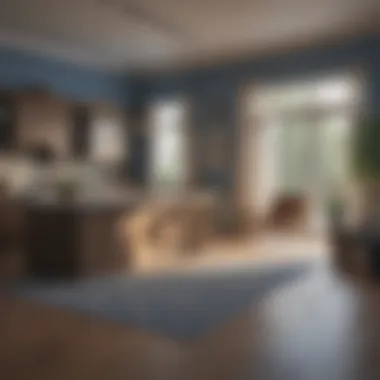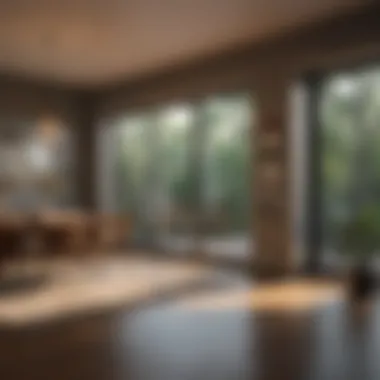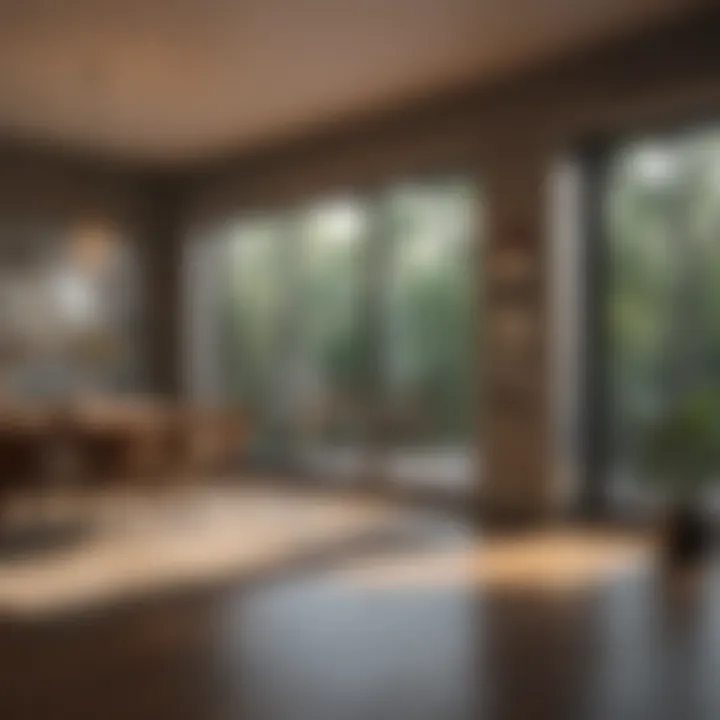Understanding Square Footage: A Detailed Guide


Intro
Accurate measurement of square footage is a crucial aspect for any homeowner or real estate enthusiast. It plays a significant role in decision-making processes such as property valuation, renovation planning, and effective property management. Understanding how to properly measure and calculate square footage helps in assessing the true value of a home, as well as maximizing its potential utility.
This guide intends to clarify the various methods of measuring square footage. Different architectural features and their implications for measurement will also be explored. By delving deeply into this topic, we aim to equip readers with the necessary knowledge to perform measurements efficiently, ensuring they can depend on the accuracy of the data they collect.
Next, we move to the section on Architectural Inspiration, where we discuss different design styles and innovative materials that can affect measurements and perceptions of space.
Prologue to Square Footage
Measuring square footage may seem like a straightforward task, yet it encompasses various nuances that are critical to grasp. The topic serves as a foundation for understanding how space is quantified and valued in different contexts, such as real estate transactions and home renovations. Understanding square footage helps homeowners and prospective buyers make informed decisions based on accurate space evaluations.
Square footage is not just a number; it represents the area within a property, which can significantly affect its market value and functionality. When you know the precise square footage of your home, you are better equipped to assess various aspects, from pricing to design choices. Whether you plan to sell your property or simply wish to understand its layout better, knowing the square footage is essential.
Defining Square Footage
Square footage is a measurement of area expressed in square units, typically feet in the United States. Determining square footage involves calculating the surface area of a given space, which can be a room, a house, or even a piece of land. This measurement is generally achieved by multiplying the length of the space by its width.
For instance, if an area measures 20 feet in length and 15 feet in width, the square footage calculation would be:
Thus, the room in this example has an area of 300 square feet. However, accurately measuring square footage requires a thorough understanding of what components are included in the calculation, as there are distinctions between different types of square footage measurements.
Importance of Knowing Square Footage
Knowing the square footage of a property carries several benefits that extend beyond mere curiosity. Understanding your home's square footage can influence your approach to renovations, as it guides you in budgeting and planning for space optimization. Here are a few reasons why this knowledge is important:
- Real Estate Valuation: Accurate square footage plays a pivotal role in determining market value. Real estate agents and buyers both rely on precise measurements to assess a property’s worth.
- Space Planning: When redesigning interiors, knowing the exact square footage helps in selecting the right furniture, décor, and layouts that fit the available space.
- Legal and Financial Implications: Miscalculating square footage can lead to legal disputes or financial discrepancies when buying, selling, or renting a property. Accurate measurements help to avoid these complications.
- Resale Potential: Properties with well-defined, accurate square footage tend to attract buyers more easily in the market.
In summary, a solid understanding of square footage is invaluable in various facets of home ownership and real estate transactions. It lays the groundwork for strategic decisions, ensuring that you make informed choices about your property.
Types of Square Footage Calculations
Understanding the types of square footage calculations is a critical aspect of measuring any home. These calculations serve distinct purposes depending on the context in which square footage is used, whether it’s for real estate transactions, renovation projects, or general home assessment. The information derived from these calculations affects property value, planning, and even compliance with building regulations. Knowing the differences between gross, net, and usable square footage allows homeowners and prospective buyers to make informed decisions. Each type of calculation encompasses unique considerations and benefits that can ultimately impact the assessment of living spaces.
Gross Square Footage
Gross square footage is often the most straightforward calculation and includes every area within a home's boundaries. This calculation encompasses all finished and unfinished areas within the exterior walls, covering spaces like garages, basements, and attics. It helps provide an overall snapshot of a property's size.
Benefits of Gross Square Footage:
- Comprehensive Overview: It's a useful metric for buyers comparing properties, as it gives a complete view of the space.
- Regulatory Use: Many local and municipal codes use this measure for compliance purposes.
However, it is essential to note that gross square footage can be misleading. It includes areas that may not be usable for living, which can inflate a property's perceived value. In many real estate listings, gross square footage is prominently displayed, helping potential buyers gauge the size of the property without diving deeply into specific functionalities of different rooms.
Net Square Footage
Net square footage accounts for usable space by excluding walls, corridors, and other non-livable areas. This calculation focuses specifically on space available for living purposes, providing a more accurate representation of functional space within a property.
Important Considerations for Net Square Footage:
- Accurate Assessment: By isolating usable living areas, this figure helps potential buyers understand the true functionality of a space.
- Helpful for Renovations: Homeowners planning renovations can gauge the amount of livable area that may be affected.
Calculating net square footage requires careful measurement and the exclusion of irrelevant areas. This calculation becomes particularly beneficial when comparing homes with different layouts and design features, providing clarity on what can actually be used versus what is merely space.
Usable Square Footage
Usable square footage further narrows down measurements to the space available for activities like living, working, or recreation, omitting areas such as closets, hallways, and thick walls. This calculation is commonly applicable in commercial real estate but also finds relevance in residential situations.


Key Elements of Usable Square Footage:
- Functional Layout: Buyers and renters see exactly how much space they can utilize for their needs, making this measurement practical for determining value in context.
- Adapting to Lifestyle: When homeowners are considering an open concept living area or multifamily home, usable square footage can help in designing for lifestyle suitability.
Combining knowledge of gross, net, and usable square footage equips homeowners and buyers with a comprehensive understanding of their property. This understanding reflects a balance between appreciating overall space and maximizing its practical application.
Preparation for Measurement
Preparation for measuring square footage is an essential stage that lays the groundwork for accurate results. Understanding this phase ensures that one captures a true representation of the living space. It includes recognizing the tools required and devising a systematic approach to measuring. This preparation helps to avoid common pitfalls and errors, thus making the process smoother and more efficient.
Gathering Necessary Tools
The first step in preparation involves gathering all the necessary tools for the measurement process. Having the right equipment on hand can significantly enhance accuracy and efficiency. Commonly used tools include:
- Measuring Tape: A long measuring tape is ideal for obtaining linear dimensions. It should be at least 25 feet in length to accommodate most room sizes.
- Laser Measure: For those looking for modernity, a laser measure can quickly provide distances with high accuracy. This tool is particularly useful for larger spaces.
- Graph Paper: Recording dimensions on graph paper helps visualize the layout. Properly scaling the measurements can provide a helpful reference.
- Calculator: Basic arithmetic skills are crucial, but having a calculator can speed up the process, especially when converting units.
- Notebook or Digital Device: Recording data prevents loss of information. It can be simple notes or digital entries in a mobile app.
Each tool plays a specific role in the overall measurement process. Ensuring they are accessible before starting will save time and frustration.
Creating an Efficient Plan
Creating an efficient plan is equally important for a successful measurement endeavor. This plan not only organizes the steps but also determines the order in which measurements are taken. Consider the following elements:
- Outline the Rooms: Start by identifying all the rooms in the home that need measuring. This includes areas like lofts, basements, and attics.
- Set a Sequence: Establish a logical sequence for measuring each room. Typically, measuring from larger to smaller spaces can help maintain clarity.
- List Measurement Points: Make a checklist of all corners and boundaries of each room to ensure no areas are overlooked.
- Allow Time: Reserve sufficient time for the task. Rushing can lead to mistakes, so it is better to plan for a thorough measurement process.
By carefully organizing the approach to measurement, one can minimize errors and obtain more reliable data. An efficient plan will contribute to a more comprehensive understanding of the home’s square footage.
Measuring Interior Spaces
Measuring interior spaces is a fundamental aspect of understanding square footage. This process not only aids in accurate calculations but also has broader implications in real estate, renovations, and space optimization. By methodically measuring interior areas, homeowners and enthusiasts establish a clear understanding of how much livable space is available, which is crucial when contemplating any real estate transactions or design changes.
Steps for Accurate Measurement
Accurate measurement requires meticulous attention to detail. Here are some steps to ensure precise square footage calculations:
- Gather the Right Tools: You will need a tape measure, a notepad, and possibly a laser measure for larger spaces.
- Plan Your Approach: Start from one corner of a room and work in a systematic fashion. Moving clockwise helps maintain organization.
- Record Dimensions: Measure the length and width of each room individually, noting the dimensions on your notepad.
- Account for Features: Include fixed features like closets and built-in shelves, which may alter the usable measurements.
- Double-Check Measurements: It is wise to measure twice to confirm accuracy.
Following these steps enables anyone to produce reliable measurements, minimizing errors in calculations later.
Identifying and Measuring Different Rooms
Different rooms often have varying shapes and features, and this can affect calculations. Here’s how to approach distinct spaces:
- Living Rooms: Typically rectangular, make sure to measure along the wall edges, noting differences if there are alcoves or unique cutouts.
- Bedrooms: Measure width and length, ensuring you include areas around doors and windows.
- Kitchens: Pay close attention to appliances and built-ins, as these can alter the overall usable square footage.
- Bathrooms: For small rooms, measuring can require more precision. Note any plumbing fixtures that may influence space usability.
Accuracy in identifying and measuring each type of room ensures a comprehensive understanding of the total square footage.
Accounting for Irregular Shapes
Irregular shapes can complicate square footage calculations but can be handled effectively:
- Divide into Rectangles: Split the space into smaller rectangular sections which are easier to measure. Calculate each section’s area separately and sum them.
- Use Trigonometric Principles: For very odd shapes, knowing basic trigonometry can help estimate space based on known angles and lengths.
- Sketching the Layout: A simple sketch can assist in visualizing the layout, making it easier to calculate square footage accurately.
"Understanding the various shapes and how to calculate them is essential for accurate square footage measurement."
Implementing these methods will increase your accuracy when dealing with challenging spaces, ultimately leading to better overall calculations.
Calculating Total Square Footage
Calculating the total square footage of your home is a fundamental aspect of home evaluation and improvement. Accurate measurements can significantly influence various decisions, making it essential to get this right. The total square footage serves as a reference in real estate listings, renovation projects, and property appraisals. By understanding how to calculate this figure, homeowners can gain insights not just into their property’s space, but also into its market value.


This section will examine the formulas needed to derive an accurate square footage measurement and discuss the steps involved in summing up the measurements.
Formulas to Use
To calculate total square footage accurately, it is vital to use the correct formulas tailored to your specific situation. There are different scenarios when measuring spaces, and depending on the shape and layout of the areas in question, you might apply one or more of these formulas:
- For Rectangular or Square Rooms:
Total Area = Length × Width
This straightforward formula applies to rooms that are uniformly rectangular. Simply measure the length and width of the room in feet, and multiply the two numbers. - For L-shaped Rooms:
Break the room into two rectangles. Calculate the area of each rectangle separately and then sum the two areas.
Area 1 = Length 1 × Width 1
Area 2 = Length 2 × Width 2
Total Area = Area 1 + Area 2 - For Circular Rooms:
Total Area = π × (Radius)²
This formula applies for circular spaces and requires knowing the radius of the room. - For Irregular Spaces:
It might be necessary to measure and break down complex areas using grid methods or triangulation. You may also divide the space into manageable segments, calculate them individually, and then sum them for accuracy.
Using precise measurements is crucial. Be sure to measure every room carefully and avoid any calculations based on estimates.
Summing Up Measurements
Once you have obtained the individual measurements for each area, you can move on to summing them up to arrive at your total square footage. Here’s a methodical approach:
- List all the measurements you have recorded for each room or area.
- Verify each measurement for accuracy prior to summation. Accuracy ensures reliability in your final figure.
- Sum the individual square footage amounts. This could be done manually or via a calculator to prevent any calculation errors.
"Attention to detail in measuring may make a difference in property valuation and investment choices."
Factors Affecting Square Footage Calculation
Understanding the specific elements that influence square footage calculations is vital for accuracy in assessments. This section delves into two primary considerations: ceiling height and built-in features or fixtures. Each factor plays a significant role in determining how space is categorized and valued, especially in real estate markets.
Ceiling Height Considerations
Ceiling height can have a profound effect on how square footage is perceived and utilized. Standard ceiling heights typically range from eight to nine feet in residential spaces. However, any deviation from this standard can affect both the practical usability and the perceived value of the property.
For instance, higher ceilings create an illusion of more space, which can be attractive to potential buyers. Homes with ceilings exceeding nine feet may have their square footage calculated differently or noted for their 'volumetric' advantages. In contexts like real estate appraisal, assessing a home with unusually low ceilings may result in a lower estimation of value, even if the actual floor space is adequate. The rationale is straightforward: lower ceilings can create a feeling of confinement, reducing the overall desirability of a room.
Built-in Features and Fixtures
Built-in features and fixtures must also be taken into account when calculating square footage. These elements include items like cabinetry, wall units, and other fixed installations that occupy space but do not contribute to livable area. The presence of such features can lead to discrepancies in measurements if not acknowledged properly during the calculation process.
When assessing square footage, it is essential to determine whether these built-in elements should be included in the total. For example, a home with extensive built-in cabinetry may have less usable square footage compared to a home with the same floor plan but fewer fixtures. This can impact how a buyer perceives the space. Moreover, when we factor in potential renovations, understanding how built-in features impact square footage can guide decisions about which renovations will be most beneficial or cost-effective.
Proper consideration of ceiling height and built-in fixtures leads to more accurate square footage measurements, ultimately influencing real estate values and buyer interest.
These factors illustrate the complexities involved in calculating square footage. Accurate measurement considers not only the physical space but also the qualitative aspects of how that space functions. The next sections will explore measurement errors and methodologies that can help ensure correctness in square footage assessments.
Square Footage in Real Estate
Square footage plays a critical role in the real estate market. Understanding its significance can impact various decisions, from pricing to marketing strategies. Real estate agents and potential buyers alike often rely on square footage metrics to evaluate properties fairly. This section will explore how square footage ties into property value and market standards, providing insights for real estate enthusiasts, interior design aficionados, and homeowners.
Impact on Property Value
The square footage of a property is often the first aspect appraisers and buyers consider when determining property worth. In many cases, larger homes can command higher prices per square foot. A more expansive home typically indicates comfort and more living space. However, not all square footage is equal, as the layout and functionality of the space matter significantly. For instance, a 2,000 square foot home with a poor layout might be less appealing than a more efficiently designed 1,800 square foot home.
Additionally, different neighborhoods have varying pricing benchmarks for square footage. A direct comparison of homes requires understanding these nuances. It’s not just about the number; it’s about how the space is utilized, the ease of flow, and how well the design meets potential buyers' needs.
"In real estate, square footage isn't merely about area; it's about value perception, which can change based on location and layout."
Investors often factor in square footage to estimate renovation costs or potential rental income as well. A well-measured space allows for deeper analysis of profit potential and investment viability.
Market Standards and Expectations
In the realm of real estate, square footage sets industry standards and forms buyer expectations. Buyers frequently use square footage to narrow their search criteria. Listings typically feature square footage prominently, emphasizing its importance in making a swift decision.
Market variability also affects how square footage is marketed. A town with expanded land may have different pricing structures compared to a densely populated city. Buyers expect these market trends to reflect not just size but livability.
Real estate professionals must communicate square footage clearly and accurately. Listing agents should follow reputable guidelines while accounting for specific characteristics like basement space or attic conversions that might influence price.


In terms of resale value, properties that meet or exceed average square footage for their area typically attract more interest. Buyers often have a baseline of what they expect for their investment, influenced by both market history and performance. Moreover, potential buyers might compare several homes based on their square footage, leading them to conclude which property offers the best value.
Individuals looking to sell should ensure accurate measurement and representation of their home's square footage to remain competitive in the market. Misrepresentations can lead to distrust, affecting not only the specific sale but also future prospects in real estate operations.
By understanding how square footage affects property value and aligning with market standards, both buyers and sellers can navigate the real estate landscape with insight, ensuring they make informed decisions.
Common Measurement Errors
Understanding common measurement errors is crucial for accurately assessing square footage. Errors can lead to discrepancies that impact decisions in areas like real estate valuation or renovation planning. By addressing these mistakes, homeowners and enthusiasts can ensure that they get the exact figures they need.
Overlooking Spaces
A frequent mistake involves ignoring smaller or less obvious spaces. Areas such as closets, hallways, and utility rooms can significantly influence total square footage yet are sometimes forgotten during measurement. When these spaces are excluded, the total might present a misleading picture of the property's size. It is vital to include every room and nook during the measuring process.
For a comprehensive measurement, consider:
- Closets: Often considered secondary, they can add substantial value to the overall square footage.
- Hallways: These corridors connect different areas of the home and should not be overlooked.
- Basements and Attics: These spaces often have potential for utility, but their dimensions should always be factored into measurements.
Overall, failing to account for these significant areas can lead to underestimating the property's true size.
Incorrect Calculations
Mistakes in basic math processing are another common source of error. Simple miscalculations can derail even the most diligent measuring efforts. It is essential to apply the correct formulas to compute square footage accurately.
Common incorrect calculations include:
- Multiplying Dimensions Incorrectly: When measuring, always double-check that the length and width are accurately plugged into the formulas.
- Misplacing Decimals: Ensuring that decimal points are correctly positioned in calculations can help maintain precision.
To mitigate these errors, follow a structured approach:
- Double-check Measurements: Before calculating, remeasure all dimensions.
- Use Reliable Tools: Implementing tools like tape measures or laser measuring devices can improve accuracy.
- Review Calculation Steps: Make sure each calculation is clear and logical, confirming each part of the process.
"Measurement is not just about accuracy; it is about detail and thoroughness. Including every aspect of a space cements your data's credibility."
In essence, awareness of common measurement errors can greatly enhance the accuracy of square footage calculations. By recognizing the importance of thoroughness and precision, individuals gain the confidence needed to make informed real estate and design decisions.
Tools and Resources for Measurement
Accurate measurement of square footage requires appropriate tools and resources. This section evaluates the various methods available, which impact the precision and efficiency of the process. Knowing the right tools can simplify measurements, prevent errors, and ultimately save time. An effective measurement strategy enhances the understanding of one's property, benefiting homeowners, renters, and real estate professionals alike.
Traditional Methods
Traditional measurement methods have been the cornerstone of calculating square footage for many years. One of the primary tools used in this approach is the tape measure. A standard tape measure allows users to manually take measurements of walls and rooms. This method demands a high level of attention to detail, especially when recording lengths and widths. The accuracy of these readings is paramount since small errors can lead to significant discrepancies in the final square footage.
To ensure efficient measurements, it is essential to follow a systematic approach:
- Plan the Measurement Route: Identify the rooms and areas to measure beforehand.
- Take Multiple Readings: Measure each dimension at least twice to confirm consistency.
- Document Findings: Write down measurements clearly to avoid confusion later on.
Another common method is the use of graph paper. Drawing the layout of a home to scale can help visualize different areas. This not only aids in calculating square footage but also in planning renovations or other modifications. While this old-school technique has its merits, it can be tedious and time-consuming.
Digital Measurement Tools
The rise of technology has brought forth digital measurement tools that greatly enhance the process of measuring square footage. These devices offer features that improve accuracy and efficiency. Laser distance measurers are one such tool, providing precise readings with just a click. They can measure long distances quickly and automatically calculate square footage when two measurements are entered.
Digital measuring apps have also gained popularity. Many smartphones and tablets now offer applications capable of using camera imaging to provide measurements. Users can simply take a photo of a room, and the app calculates the dimensions based on the perspective of the image. Although this technology can yield quick results, it is important to check the app’s calibration to ensure accuracy.
Some notable tools include:
- Laser Distance Measurer: For quick and precise linear measurements.
- Smartphone Measurement Apps: Convenient and user-friendly for quick evaluations.
- 3D Scanning Devices: For comprehensive capture of complex spaces.
Ending
Accurately measuring square footage of your home is not just a technical task; it is crucial for many practical outcomes. Having a clear understanding of how to measure your home equips homeowners, real estate professionals, and design enthusiasts alike with the ability to make informed decisions. Whether you are planning a renovation, setting a property value, or simply improving the use of space, knowing the exact square footage is essential.
Summary of Key Points
- Accurate Measurement: A proper understanding of measurement techniques ensures reliability in the calculations.
- Use in Real Estate: The value of properties heavily influences market behavior, making square footage a vital metric.
- Common Errors: Awareness of typical measurement mistakes helps improve accuracy, ensuring every square foot counts correctly.
- Tools Available: Familiarity with both traditional and digital measurement tools expands options for achieving precise calculations.







